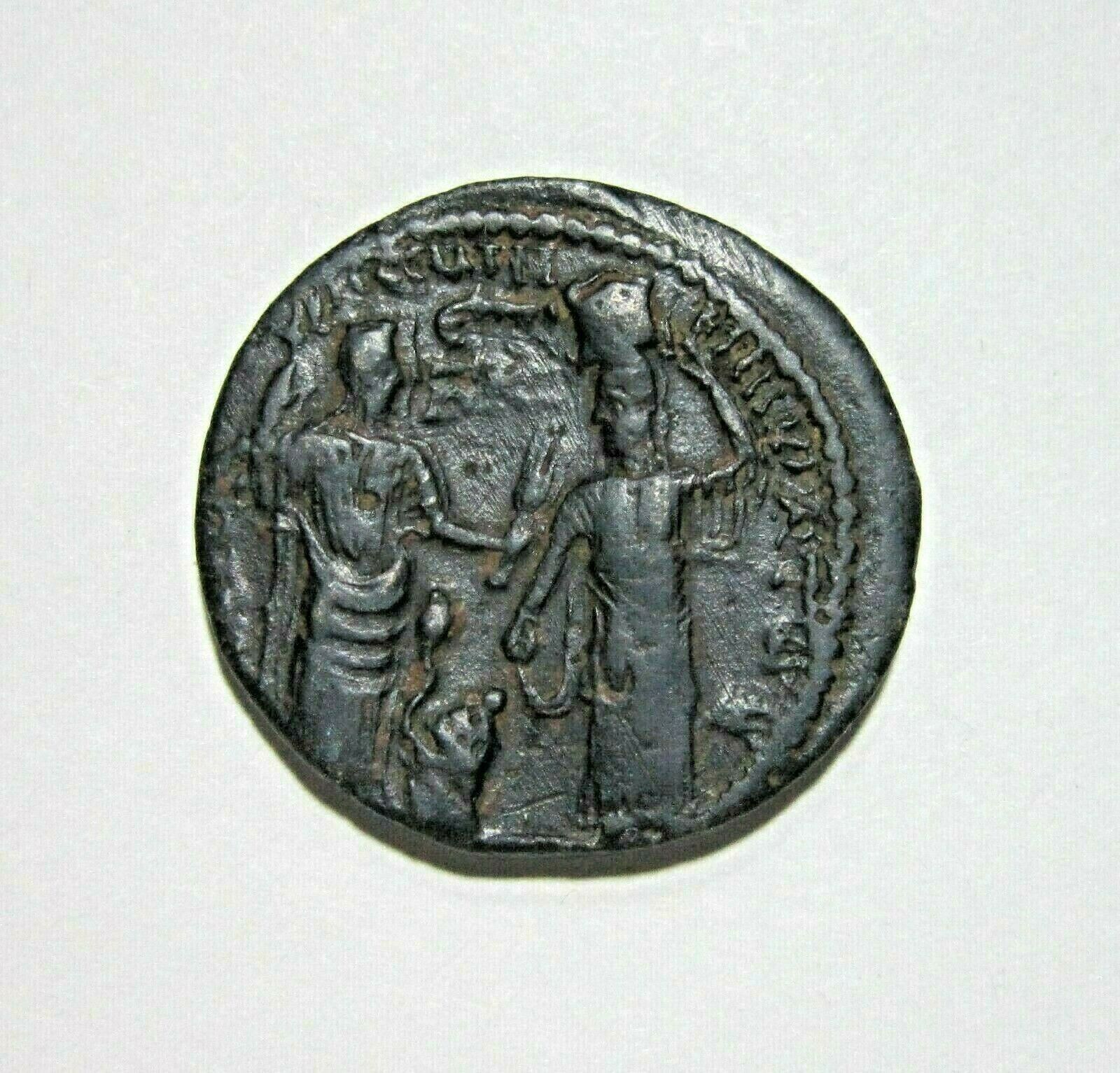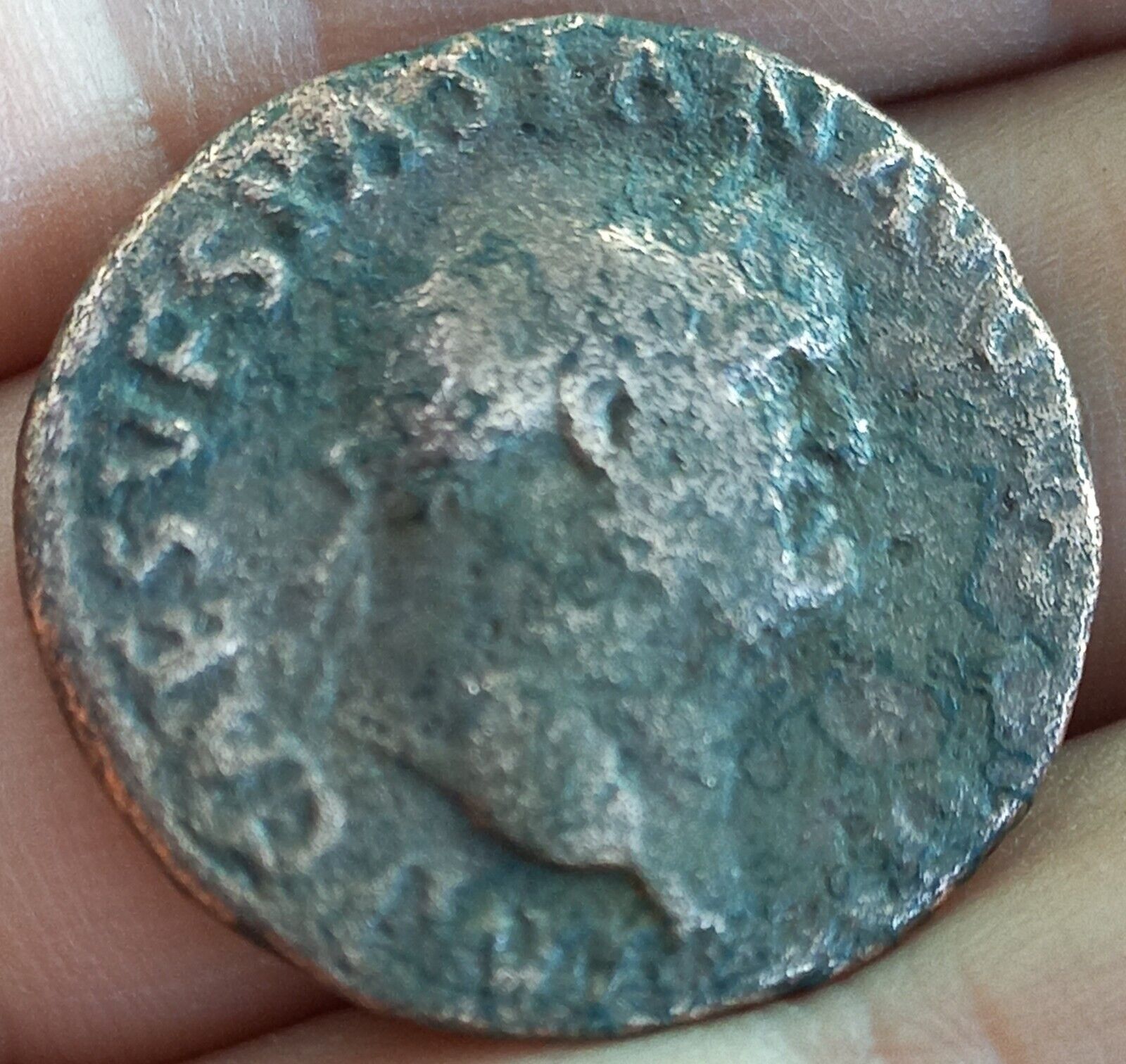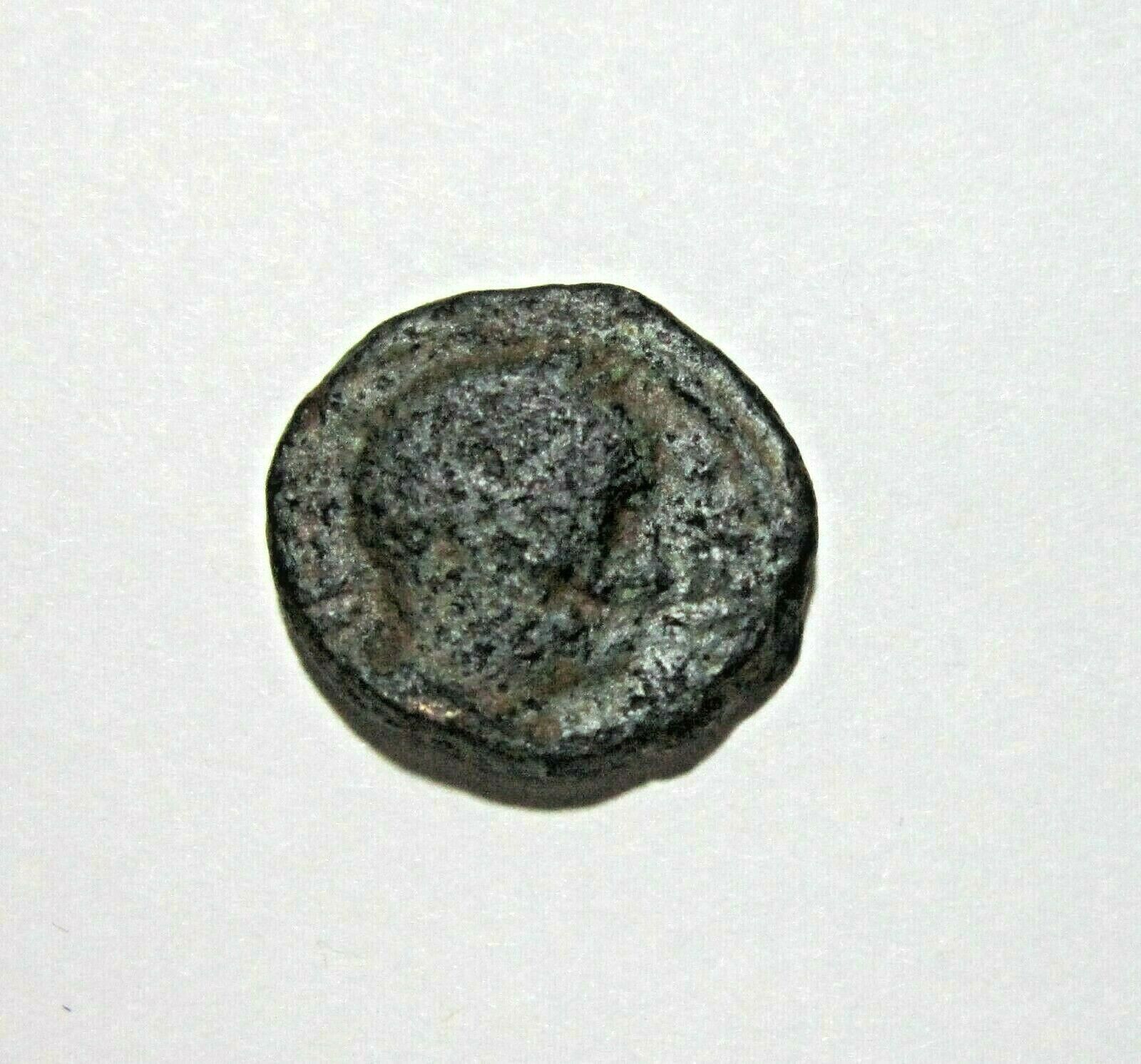-40%
RHESKUPORIS V CONSTANTINE the GREAT 326AD Bosporus Provincial Roman Coin i53651
$ 52.8
- Description
- Size Guide
Description
Item:i53651
Authentic Ancient Coin of:
Kingdom of
Bosporus
Rheskuporis V
- King, circa 304-343 A.D.
Rheskuporis V
& Constantine I, the Great
Bronze Stater 19mm (7.21 grams) Struck year 623 of Bosporus Era (starting October, 297 B.C.), 326/327 A.D.
Reference: Anohin 772d;
Frolova pl. 71, 26
ΒΑCΙΛЄVC ΡICΚΟVΠΟΡ, His diademed and draped bust right; wreath before.
Laureate and draped bust of Roman emperor Constantine I, the Great right; in field to right, star; date, ΓKX below.
You are bidding on the exact item pictured, provided with a Certificate of Authenticity and Lifetime Guarantee of Authenticity.
The
Bosporan Kingdom
, also known as the
Kingdom of the Cimmerian Bosporus
(
Greek
:
Βασίλειον του Κιμμερικού Βοσπόρου
Basileion tou Kimmerikou Bosporou
), was an ancient state located in eastern
Crimea
and the
Taman Peninsula
on the shores of the Cimmerian Bosporus, the present-day
Strait of Kerch
. (It was not named after the more famous
Bosphorus
beside
Istanbul
at the other end of the
Black Sea
.) The Bosporan Kingdom was the longest surviving Roman
client kingdom
. It was a
Roman province
from 63 to 68 AD, under Emperor
Nero
. The 1st and 2nd centuries BC saw a period of renewed golden age of the Bosporan state. At the end of the 2nd century, King
Sauromates II
inflicted a critical defeat on the
Scythians
and included all the territories of the Crimea in the structure of his state.
The prosperity of the Bosporan Kingdom was based on the export of wheat, fish and
slaves
. The profit of the trade supported a class whose conspicuous wealth is still visible from newly discovered archaeological finds, excavated, often illegally, from numerous burial barrows known as
kurgans
. The once-thriving cities of the Bosporus left extensive architectural and sculptural remains, while the kurgans continue to yield spectacular Greco-Sarmatian objects, the best examples of which are now preserved in the
Hermitage
in
St. Petersburg
. These include gold work, vases imported from
Athens
, coarse terracottas, textile fragments and specimens of
carpentry
and
marquetry
.
Early Greek colonies
Pantikapeon and other ancient Greek colonies along the north coast of the Black Sea, along with their modern names
The whole area was dotted with Greek cities: in the west,
Panticapaeum
(
Kerch
)—the most significant city in the region,
Nymphaeum
and
Myrmekion
; on the east
Phanagoria
(the second city of the region),
Kepoi
,
Germonassa
,
Portus Sindicus
and Gorgippia.
These
Greek colonies
were originally settled by
Milesians
in the 7th and 6th centuries BC. Phanagoria (c. 540 BC) was a colony of
Teos
, and the foundation of Nymphaeum may have had a connection with
Athens
; at least it appears to have been a member of the
Delian League
in the 5th century.
Geography of the Bosporan Kingdom
See also:
Roman Crimea
The Bosporan Kingdom was centred around the
Kerch Strait
between the
Black Sea
and the
Sea of Azov
, known in antiquity as the Cimmerian Bosporus from where the kingdom's name derived.
Kings of Cimmerian Bosporan
See Also:
List of kings of Cimmerian Bosporus
Archaeanactidae dynasty
According to Greek historian
Diodorus Siculus
(xii. 31) the region was governed between 480 and 438 BC by a line of kings called the
Archaeanactidae
, probably a ruling family, usurped by a
tyrant
called Spartocus (438 – 431 BC), who was a
Thracian
.
Spartocid dynasty
Spartocus founded a dynasty which seems to have endured until c. 110 BC, known as the
Spartocids
. The Spartocids left many inscriptions, indicating that the earliest members of the house ruled under the titles of
archons
of the Greek cities and kings of various minor native tribes, notably the
Sindi
(from central Crimea) and other branches of the
Maeotae
. Surviving material (texts, inscriptions and coins) do not supply enough information to reconstruct a complete chronology of kings of the region.
Bosporan
Phiale
(top view), 4th century BC
Satyrus
(431 – 387 BC), successor to Spartocus, established his rule over the whole region, adding
Nymphaeum
to his kingdom and besieging
Theodosia
, which was wealthy because, unlike other cities in the region, it had a port which was free of ice throughout the year, allowing it to trade grain with the rest of the Greek world, even in winter. Satyrus' son
Leucon
(387 – 347 BC) would eventually take the city. He was succeeded jointly by his two sons, Spartocus II, and Paerisades; Spartocus died in 342, allowing Paerisades to reign alone until 310. After Paerisades' death, a civil war between his sons Satyrus and Eumelus was fought. Satyrus defeated his younger brother Eumelus at the
Battle of the River Thatis
in 310 BC but was then killed in battle, giving Eumelus the throne.
[3]
Eumelus' successor was Spartocus III (303 – 283 BC) and after him Paerisades II. Succeeding princes repeated the family names, so it is impossible to assign them a definite order. The last of them, however, Paerisades V, unable to make headway against increasingly violent attacks from nomadic tribes in the area, called in the help of
Diophantus
, general of King
Mithridates VI of Pontus
, leaving him his kingdom. Paerisades was killed by a
Scythian
named Saumacus who led a rebellion against him.
The house of Spartocus was well known as a line of enlightened and wise princes; although Greek opinion could not deny that they were, strictly speaking,
tyrants
, they are always described as dynasts. They maintained close relations with
Athens
, their best customer for the Bosporan grain exports: Leucon I of Bosporus created privileges for Athenian ships at Bosporan ports. The Attic orators make numerous references to this. In return the Athenians granted Leucon Athenian citizenship and made decrees in honour of him and his sons.
Mithridates VI
The northern Black sea shores of the Pontic Kingdom (actual Crimea and Kerch peninsula) shown as part of the empire of
Mithridates VI of Pontus
.
After his defeat by Roman General
Pompey
in 63 BC, King
Mithridates VI of Pontus
fled with a small army from
Colchis
(modern Georgia) over the Caucasus Mountains to
Crimea
and made plans to raise yet another army to take on the Romans. His eldest living son,
Machares
, regent of Cimmerian Bosporus, was unwilling to aid his father, so Mithridates had Machares killed, acquiring the throne for himself. Mithridates then ordered the conscriptions and preparations for war. In 63 BC,
Pharnaces
, the youngest son of Mithridates, led a rebellion against his father, joined by Roman exiles in the core of Mithridates's Pontic army. Mithridates VI withdrew to the citadel in
Panticapaeum
, where he committed suicide. Pompey buried Mithridates VI in a rock-cut tomb in either
Sinope
or
Amasia
,
[4]
the capital of the
Kingdom of Pontus
.
Roman client kingdom
The
stele
of Staphhilos from the
Panticapaeum
, depicting a soldier with the traditional Bosporan long hair and beard.
After the death of Mithridates VI (63 BC), Pharnaces II (63 – 47 BC) supplicated to Pompey, and then tried to regain his dominion during Julius
Caesar's Civil War
, but was defeated by
Caesar
at
Zela
and was later killed by his former governor and son-in-law
Asander
.
Before the death of Pharnaces II, Asander had married Pharnaces II’s daughter
Dynamis
. Asander and Dynamis were the ruling monarchs until Caesar commanded a paternal uncle of Dynamis,
Mithridates II
to declare war on the Bosporan Kingdom and claimed the kingship for himself. Asander and Dynamis were defeated by Caesar’s ally and went into political exile. However, after Caesar’s death in 44 BC, the Bosporan Kingdom was restored to Asander and Dynamis by Caesar’s great nephew and heir
Octavian
. Asander ruled as an archon and later as king until his death in 17 BC. After the death of Asander, Dynamis was compelled to marry a Roman
usurper
called Scribonius, but the Romans under
Agrippa
intervened and established
Polemon I of Pontus
(16 – 8 BC) in his place. Polemon married Dynamis in 16 BC and she died in 14 BC. Polemon ruled as king until his death in 8 BC. After the death of Polemon,
Aspurgus
, the son of Dynamis and Asander, succeeded Polemon.
The Bosporan Kingdom of Aspurgus was a
client state
of the
Roman Empire
, protected by Roman garrisons. Aspurgus (8 BC – 38 AD) founded a dynasty of kings which endured with a couple of interruptions until 341 AD. Aspurgus adopted the Imperial Roman names "Tiberius Julius" when he received
Roman citizenship
and enjoyed the patronage of the first two
Roman Emperors
,
Augustus
and
Tiberius
. All of the following kings adopted these two Roman names followed by a third name, of
Thracian
(Kotys, Rhescuporis or Rhoemetalces) or local origin (such as Sauromates, Eupator, Ininthimeus, Pharsanzes, Synges, Terianes, Theothorses or Rhadamsades).
Ruins of
Panticapaeum
, modern
Kerch
, the capital of the Bosporan Kingdom.
The Roman client kings of the dynasty had descended from King
Mithridates VI of Pontus
and his first wife,
his sister Laodice
, through Aspurgus. The kings adopted a new calendar (the "Pontic Era") introduced by Mithridates VI, starting with 297 BC to date their coins. Bosporan kings struck coinage throughout its period as a client state, which included gold
staters
bearing portraits of both the Roman emperor and Bosporan king. Like the Roman, Bosporan coinage became increasingly debased during the 3rd century. The coinage makes their lineages fairly clear to historians, though scarcely any events from their reigns are recorded.
The Bosporan Kingdom covered the eastern half of Crimea and the Taman peninsula, and extended along the east coast of the
Maeotian marshes
to
Tanais
at the mouth of the
Don
in the north-east, a great market for trade with the interior. Throughout the period there was perpetual war with the native tribes of
Scythians
and
Sarmatians
, and in this the Bosporan Kingdom was supported by its Roman suzerains, who lent the assistance of garrisons and fleets.
In 62 AD for reasons unknown, Roman emperor
Nero
deposed the Bosporan king
Cotys I
. It is possible that Nero wanted to minimise the power of local client rulers and wanted the Bosporans to be subsumed into the Roman empire. The Bosporan Kingdom was incorporated as part of the Roman province of
Moesia Inferior
from 63 to 68. In 68, the new Roman emperor
Galba
restored the Bosporan Kingdom to
Rhescuporis I
, the son of Cotys I.
The balance of power amongst local tribes was severely disturbed by
westward migration
in the 3rd–4th centuries. In the 250s AD, the
Goths
and
Borani
were able to seize Bosporan shipping and even raid the shores of
Anatolia
.
[6]
With the coins of the last king
Rhescuporis VI
in 341, constructing a chronology becomes very difficult. The kingdom was probably finally overrun by the
Huns
, who defeated the nearby
Alans
in 375/376 and moved rapidly westwards towards the Roman empire.
Byzantine period
A few centuries after the Hunnic invasion, the Bosporan cities enjoyed a revival, under
Byzantine
and Bulgarian protection. The ancient Greek city of
Phanagoria
became the capital of Old Great Bulgaria between 632 and 665. From time to time Byzantine officers built fortresses and exercised authority at Bosporus, which constituted an
archbishopric
.
A relevant Byzantine usage of the term is found in a newly discovered seal of a general of the early 11th century as of “Πο<σ>φορ(ου)”, i.e., of the Cimmerian Bosporos.
They also held Tamatarcha on the eastern side of the strait, a town which in the 10th and 11th centuries became the seat of the
Kievan Rus
principality of
Tmutarakan
, which in turn gave way to
Tatar
domination.
Following the
Diaspora
, and aided by the
Khazars
,
Judaism
emerged in the region, and Jewish communities developed in some of the cities of the region (especially
Tanais
). The Jewish or Thracian influence on the region may have inspired the foundation of a cult to the "Most High God," a distinct regional cult which emerged in the 1st century AD, which professed monotheism without being distinctively Jewish or Christian.
Coinage
Although considered rare among collectors prior to the demise of the
Soviet Union
in the early 1990s, Bosporan coins are now well known on the international coin markets, hinting at the quantities produced. Several large series were produced by Bosporan cities from the 5th century BC, particularly in
Panticapaeum
. Gold staters of Panticapaeum bearing
Pan
's head and a griffin are especially remarkable for their weight and fine workmanship.
There are coins with the names of the later Spartocids and a complete series of dated
solidi
issued by the later or
Achaemenian
dynasty. In them may be noticed the swift degeneration of the gold solidus through silver and
potin
to bronze.
See also
Cimmerians
Cimmerian Bosporus
Kingdom of Pontus
Roman Crimea
Frequently Asked Questions
How long until my order is shipped?:
Depending on the volume of sales, it may take up to 5 business days for shipment of your order after the receipt of payment.
How will I know when the order was shipped?:
After your order has shipped, you will be left positive feedback, and that date should be used as a basis of estimating an arrival date.
After you shipped the order, how long will the mail take?
USPS First Class mail takes about 3-5 business days to arrive in the U.S., international shipping times cannot be estimated as they vary from country to country. I am not responsible for any USPS delivery delays, especially for an international package.
What is a certificate of authenticity and what guarantees do you give that the item is authentic?
Each of the items sold here, is provided with a Certificate of Authenticity, and a Lifetime Guarantee of Authenticity, issued by a world-renowned numismatic and antique expert that has identified over 10000 ancient coins and has provided them with the same guarantee. You will be quite happy with what you get with the COA; a professional presentation of the coin, with all of the relevant information and a picture of the coin you saw in the listing.
Compared to other certification companies, the certificate of authenticity is a -50 value. So buy a coin today and own a piece of history, guaranteed.
Is there a money back guarantee?
I offer a 30 day unconditional money back guarantee. I stand behind my coins and would be willing to exchange your order for either store credit towards other coins, or refund, minus shipping expenses, within 30 days from the receipt of your order. My goal is to have the returning customers for a lifetime, and I am so sure in my coins, their authenticity, numismatic value and beauty, I can offer such a guarantee.
Is there a number I can call you with questions about my order?
You can contact me directly via ask seller a question and request my telephone number, or go to my About Me Page to get my contact information only in regards to items purchased on eBay.
When should I leave feedback?
Once you receive your order, please leave a positive. Please don't leave any negative feedbacks, as it happens many times that people rush to leave feedback before letting sufficient time for the order to arrive. Also, if you sent an email, make sure to check for my reply in your messages before claiming that you didn't receive a response. The matter of fact is that any issues can be resolved, as reputation is most important to me. My goal is to provide superior products and quality of service.











